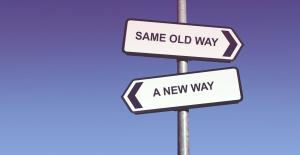People hate change. We have our habits, routines, and preferences that drive us to act, or in many cases fail to act.

When I engage with a new client, I spend a lot of time not only understanding their business processes, but also the rationale for those processes. It’s my job to question and challenge these processes, with the goal of improving (or even removing) them to create new value for my clients.
I am constantly surprised by really smart, educated clients who tell me “we’ve always done it that way,” unable to explain the reasons why things are so. They have a belief that deviating from this norm will somehow cause loss or pain.
Throw out the process manual
I’ve worked with Fortune 500 organizations that needed to innovate quickly. However, the regulatory and compliance climate of the past 15 years created processes and procedures that continued to drive organizational behavior. Traditional product development approaches took too long, and by the time the solution was delivered, it was either uncompetitive or obsolete.
My most successful clients took a leap of faith and adopted agile or lean methods to quickly deliver new offerings to customers. Initially, they resisted this major change, comfortable in their “we’ve always done it that way” approach.
I can understand their hesitation. I had one client who actually preferred a 100 page specification document, Gantt chart, work breakdown structure, fixed cost estimates, and a firm deadline. This approach offered the perception of a guaranteed budget, scope, and date. The budget, scope, and date of any project inevitably change. In over twenty years, I’ve never had a project stick to all three.
I’m not here to sell you a methodology
Consultants love their methodologies. I don’t have one to sell you because I don’t believe in one-size-fits-all when it comes to my clients’ success. What I will offer you are these advantages:
Change – We accept the fact that scope will change over the life of a project. User feedback, external factors (competitors, regulations, etc.), and unforeseen complexity are givens. We avoid failure by delivering the system that is needed, as opposed to one designed in a vacuum.
Iteration – The ideal way to address change is to work in discrete steps towards an end state that we accept to be in flux. Details change. We gain new insights along the way. We inspect and adapt. Working this way avoids costly and time consuming requirements documents. My clients’ staff is energized by being able to work on something new early and often.
Feedback – In order to identify and act upon change, we need frequent feedback. I coach most of my clients in Scrum (or some agile variant thereof), whose various “ceremonies” include a daily standup, sprint review, and retrospective. My clients welcome this approach, as changing insights, requirements, and risks are discovered regularly.
Value – I help my clients achieve business value at the end of every iteration or sprint. We will have a potentially shippable product every few weeks. This success engages customers and delights end users, where they can see the project has taken on life.
Software development is an unpredictable process. I help my clients take the risk out of the chaos.
Questions for Business Leaders:
- How easily can you adapt to rapid change with your current process?
- Are your customers involved in your product development process, or do they only see the end result?
- Does your organization collaborate, or do they follow draconian processes?
© 2015 Mark Richman. All rights reserved.